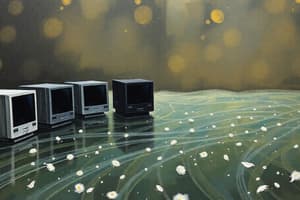Podcast
Questions and Answers
Which component was used in first-generation computers?
Which component was used in first-generation computers?
- Vacuum Tubes (correct)
- Integrated Circuits
- Transistors
- Microprocessors
Third-generation computers used punched cards for input.
Third-generation computers used punched cards for input.
False (B)
What replaced vacuum tubes in second-generation computers?
What replaced vacuum tubes in second-generation computers?
- Integrated Circuits
- Microprocessors
- Transistors (correct)
- Quantum Processors
What significant advancement did the fourth generation of computers mark?
What significant advancement did the fourth generation of computers mark?
What is a characteristic of fifth-generation computers?
What is a characteristic of fifth-generation computers?
What type of data do analog computers process?
What type of data do analog computers process?
What does the term 'computer' derive from?
What does the term 'computer' derive from?
What do digital computers represent as binary?
What do digital computers represent as binary?
Which of the following are components of the computer process?
Which of the following are components of the computer process?
What is the total due from the customer based on the provided data?
What is the total due from the customer based on the provided data?
How much change is due to the customer?
How much change is due to the customer?
What is meant by the term 'word length' in computing?
What is meant by the term 'word length' in computing?
Computers perform calculations with 100% accuracy.
Computers perform calculations with 100% accuracy.
How many instructions can a computer process in one second?
How many instructions can a computer process in one second?
A computer can perform millions of tasks without feeling _____ or lack of concentration.
A computer can perform millions of tasks without feeling _____ or lack of concentration.
Longer word lengths indicate less computing power.
Longer word lengths indicate less computing power.
What are commonly used word lengths in computers?
What are commonly used word lengths in computers?
Flashcards are hidden until you start studying
Study Notes
Generations of Computers
- First Generation: Vacuum tubes used for circuitry, magnetic drums for memory. Systems were large, expensive, and prone to malfunctions. Input via punched cards/paper tape, output via printouts. Relied on machine language for operations.
- Second Generation: Transistors replaced vacuum tubes, leading to smaller, faster, cheaper, and more energy-efficient computers. Punched cards and printouts continued for input/output. Transitioned from binary to assembly and high-level programming languages (COBOL, FORTRAN). Magnetic core technology replaced magnetic drums for memory.
- Third Generation: Integrated circuits (ICs) on silicon chips significantly increased speed and efficiency. Keyboards and monitors replaced punched cards and printouts. Multitasking became possible with a central controlling program.
- Fourth Generation: Microprocessors (thousands of ICs on one chip) marked a significant advancement. The Intel 4004 chip brought all computer components onto a single chip. Increased power, networking capabilities, and the internet emerged. Home computers were introduced by IBM and Apple with the Macintosh.
- Fifth Generation: Focus on Artificial Intelligence (AI). Voice and facial recognition are examples of current AI applications. Parallel processing, superconductors, quantum computation, and nanotechnology are expected to further revolutionize computing capabilities. The goal is to develop devices capable of natural language interactions and learning.
Classification of Computers
- Analog Computer: Processes continuously varying data like sound, sight, electrical current, frequency, and resistance. Used in scientific and industrial applications.
- Digital Computer: Processes discrete signals (high/low voltage) representing numbers, alphabets, and symbols as binary (1s and 0s). Fast electronic devices used for calculations, comparisons, and sorting.
Computer Definition
- A computer is an electronic device capable of receiving input, processing data, producing output, and storing information for future use.
- Computers operate under the control of instructions stored in their memory.
Computer Process
- Input: Information entered into the computer (e.g., data, commands)
- Process: The computer performs operations on the input data according to instructions.
- Output: The processed information is presented to the user (e.g., results, displays)
- Storage: Information can be saved for future use or retrieval.
Data & Information
- Data represents raw facts and figures.
- Information is processed data that provides meaning and context.
Word Length
- Computers use binary digits (bits: 0 and 1) for processing information
- Word Length: The number of bits a computer processes simultaneously.
- Longer word lengths generally indicate more powerful computers.
Computer Speed
- Computers work significantly faster and more accurately than humans, especially in mathematical calculations.
- They can process millions of instructions per second.
- Operations are measured in microseconds and nanoseconds.
Computer Accuracy
- Computers perform calculations with high accuracy, usually 100%.
- Errors can occur due to inaccurate data or programming issues.
Computer Diligence
- Computers can perform tasks consistently and tirelessly without fatigue.
- They maintain a high level of accuracy and concentration.
- Their memory capabilities surpass human memory.
Studying That Suits You
Use AI to generate personalized quizzes and flashcards to suit your learning preferences.




